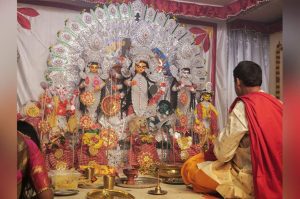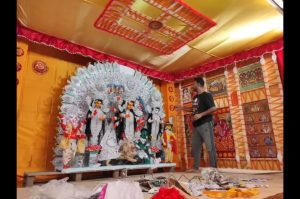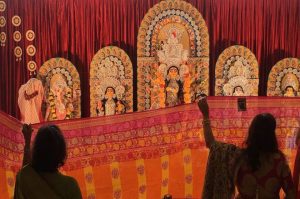When Durgaville in Germany Transforms: In the heart of Bavaria, thousands of kilometres away from the ghats of the Hooghly and the vibrant streets of Kolkata, the unmistakable energy of Bengal’s biggest festival takes form in an unlikely place — Erlangen, Germany. Here, “Durgaville” has emerged as more than just a religious gathering. It has become a cultural extravaganza that redefines the diaspora’s connection to roots, recreates the festive spirit of Bengal abroad, and embodies how Durga Puja has transcended borders to become a global cultural heritage.

What started as a small initiative by three Bengali families in 2021 has now become a cornerstone of the Indian community’s cultural life in Erlangen. Over just five years, it has grown into a celebration involving more than seventy participants, with rituals, themed decorations, locally crafted idols, and cultural performances that echo the soul of Bengal.
A Festival Born of Longing and Belonging
For Bengalis worldwide, Durga Puja is far more than ritual. It is an emotion, a celebration of community, and a reaffirmation of cultural identity. Away from home, however, that emotion often turns into nostalgia. It was this nostalgia that led to the birth of Durgaville.


Organisers describe it as an “act of homemaking” — the attempt to create a Kumortuli (the idol-making hub of Kolkata) in Germany. By bringing Ma Durga into their adopted land, they connect memory with presence, ensuring their children and fellow expatriates experience the festival not as a distant story but as a lived reality.
Idol Made of German Soil
One of the most symbolic decisions of Durgaville is the crafting of idols using local German soil. Dipankar Sarkar, an IT professional with artistic skills, sculpts the idols himself. This shift from importing idols from India to making them locally signifies adaptation, sustainability, and a sense of rootedness in the new homeland.
Such practices echo global patterns of diaspora adaptation. Communities in the UK, USA, and Canada have also moved towards locally made idols, sometimes even adopting eco-friendly approaches (UNESCO Intangible Cultural Heritage).
When Durgaville in Germany Transforms: Rituals Across Time Zones
Durga Puja follows a strict lunar calendar, but translating it to a European setting comes with challenges. If rituals were followed in sync with India, they would fall at impractical hours for participants in Germany. Durgaville solves this by adapting the timings to German local time, while maintaining respect for astrological traditions.


This innovation allows the community to balance spiritual authenticity with practical inclusivity, ensuring that professionals, students, and families can all participate meaningfully.
Thematic Celebrations: Recreating Bengal’s Aesthetic Abroad
Like Kolkata’s renowned theme pujas, Durgaville too has embraced creativity. In one edition, the team recreated the historic Itachuna Rajbari of Hooghly district, turning their venue into a miniature Bengal mansion.
Themes add depth and aesthetics, helping children and non-Bengali visitors understand the cultural and architectural richness of Bengal. Such initiatives reflect the larger trend of Durga Puja as a global cultural showcase — an element that contributed to its recognition by UNESCO as an Intangible Cultural Heritage of Humanity in 2021 (UNESCO listing).
Cultural Programmes and Community Engagement
Beyond worship, Durgaville thrives as a platform for cultural expression. Performances of Rabindra Sangeet, recitations, dance dramas, painting competitions, and fashion shows all find space here. Children are introduced to Bengali literature, music, and stories, while adults share memories of their childhood pujas in Kolkata.
The cultural segment is not only entertainment but also a tool for heritage transmission. For second-generation Bengalis born abroad, it becomes a classroom of identity, bridging them with their ancestral homeland.
Challenges of Hosting a Diaspora Durga Puja
Organising a full-fledged Durga Puja in Europe is no small feat. The Durgaville organisers face hurdles that range from finances to logistics:
- Venue and permissions: Negotiating with local authorities for halls, sound permits, and fire safety compliance.
- Budgeting: Relying on community contributions and small sponsorships, unlike Kolkata’s corporate-backed mega-pujas.
- Manpower: Managing everything through volunteers balancing studies and jobs.
- Storage and transport: Handling decorations, lights, and sound equipment in a country without the ready pandal ecosystem of Bengal.
Yet, these challenges are also opportunities — they foster solidarity and deepen the sense of collective ownership among members.
Symbol of Identity, Memory and Continuity
For the diaspora, Durga Puja is both memory and reinvention. It reminds them of Kolkata’s streets glowing with lights and dhakis’ beats, while also demanding new rituals of adaptation — German soil for idols, adjusted time zones for rituals, modern logistics in a European setting.
Durgaville becomes a space where nostalgia is transformed into creativity, where the second generation is introduced to heritage, and where Bengal’s cultural spirit lives in Europe’s heart.
Durgaville in the Context of Global Durga Puja
Durgaville is part of a much larger phenomenon. From London’s Camden Puja to New Jersey’s Durga Puja and from Dubai’s Bengali associations to Singapore’s temple pujas, the goddess has truly gone global.
Durga Puja abroad has become both a spiritual and a social hub. It connects communities, fosters cross-cultural exchange, and even serves as a form of cultural diplomacy. In fact, the Indian government often supports such diaspora initiatives under its soft power strategy (Indian Council for Cultural Relations).
Looking Ahead: Sustaining the Spirit
As Durgaville enters its next chapter, questions of sustainability and growth emerge. Can it expand its reach to non-Bengali locals in Erlangen? Will future generations maintain the same passion? Can it attract sponsorship or recognition at a larger scale?
The answers lie in its ability to balance tradition with reinvention. By continuing to innovate — through eco-friendly idols, inclusive cultural programming, and digital documentation — Durgaville can ensure its legacy thrives for decades to come.
Conclusion: The Miracle of Home Away from Home
When the lights glow on the pandal in Erlangen and the fragrance of incense mingles with the crisp Bavarian air, one truth becomes clear: Durga Puja is not bound by geography. Its essence — of community, creativity, faith, and joy — transcends borders.
Durgaville is not just a festival; it is an emotion rebuilt in exile, a bridge between Kolkata and Germany, a living proof that traditions can travel, adapt, and blossom in foreign soil.
In the words of UNESCO’s recognition: Durga Puja is not just ritual, but a social and cultural carnival of the community. Durgaville proves this once again — that no matter where Bengalis go, they carry their goddess, their culture, and their unbreakable spirit with them.
🔗 External references for deeper reading:
- Durga Puja in Kolkata – UNESCO Intangible Cultural Heritage
- Indian Council for Cultural Relations (ICCR)
- German-Indian Association (DIG) cultural exchanges
Also read: Home | Channel 6 Network – Latest News, Breaking Updates: Politics, Business, Tech & More

